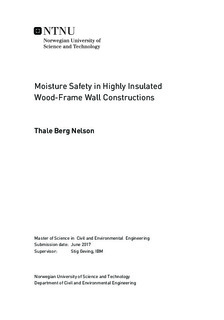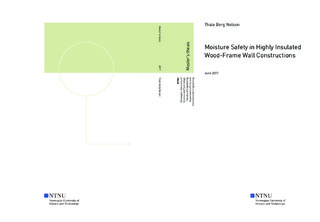| dc.description.abstract | This report addresses moisture safety in highly insulated wood-frame walls. Research shows that the risk of moisture damages may increase with the thickness of the insulation layer. The possible consequences of increased insulation layers are reduced temperatures in the exterior part, more built-in moisture in the construction, reduced drying capacity and increased internal natural convection, which may lead to moisture damages. One of the major threats of elevated moisture levels in wood-frame constructions may be the risk of fungal growth, such as mould.
The purpose of this study is to examine the effect on the moisture conditions in highly insulated wood-frame walls, when using thermal insulating materials as a weather barrier. One of the main question of interest, is whether this solution will improve the moisture safety compared to using traditional types of weather barriers. In addition, there is a question of which materials may be suitable.
The first part of the study is a literature search and is a study of existing literature and research on moisture issues related to highly insulated walls, weather barriers and external insulation. In addition, different products from manufacturers have been researched in order to find interesting products, mainly rigid foam, wood fibre and mineral wool products, to be used in the moisture simulation.
A summary of the literatures search shows there may be a somewhat elevated risk of high moisture levels and mould growth in highly insulated walls compared to walls with less insulation. This negative effect of the insulation thickness on moisture levels can be influenced by many factors, such as the choice of materials, climate, moisture gains from the indoor air and air flow rate in the air gap. Laboratory investigations indicate that the choice of weather barrier may be of great importance for the moisture level in wall constructions. Weather barrier materials with higher thermal resistance and vapour permeability, may reduce the risk of moisture issues.
The second part of the thesis are the three parametric studies of hygrothermal simulations in WUFI. The calculations assess the use of exterior insulation as a measure to improve the moisture conditions in highly insulated wood-frame walls in a Norwegian climate. The wall construction in the parametric studies is limited to a common type of wood-frame wall. The influence of different insulating weather barrier products and the thickness of the material layers are the main parameters that are variated, in addition to different climates an initiation time of the calculations.
The results from the simulations are used to evaluate the moisture conditions in highly insulated walls when using weather barriers of materials with high thermal resistance versus a traditional weather barrier, in addition to assessments of the moisture safety based on quantitative criteria for moisture damages, such as mould growth.
The first study investigates the use of wood fibre boards as weather barriers. The results indicate that wood fibre boards may function well as weather barrier, and may even be more safe than conventional weather barriers. However, in the initial phases of the simulation periods, mould growth on an unacceptable level occurred. It may be desirable to achieve an acceptable level of growth in the initial stages.
Therefore, the second study further investigates the use of wood fibre boards as weather barriers. In this study, most of the simulations starts in May, as opposed to in the first study, when the starting point is in January. This seems improve the results, as the mould growth is at an acceptable level in many simulation cases. The conventional weather barrier also has an improvement, but the RH levels in the dynamic cycles are still at a concerning level.
The third study investigates the use of rigid foam boards used as weather barriers. When the simulations start in January, the product results in very high initial levels of mould growth and very high RH levels, which may result in condensation. Starting in May, the initial mould growth is somewhat reduced, but the risk of condensation seems to be eliminated. The product does however result in low RH values after the initial moisture dries when thicker boards are used. | |

